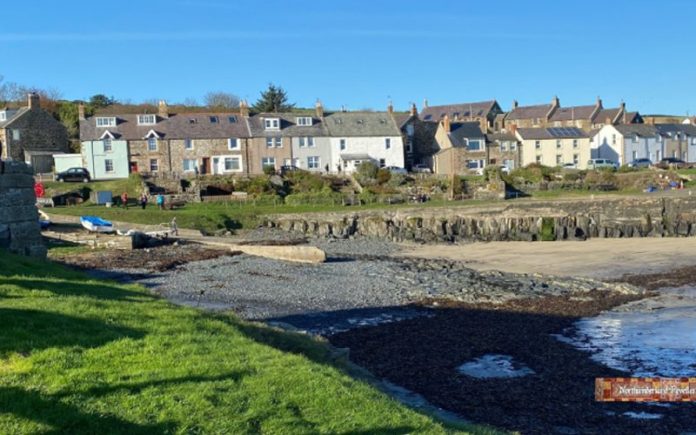
Craster is a tiny village (population 305 in a 2011 census) and popular tourist destination within the Northumberland Coast Area of Outstanding Natural Beauty.
Local fishermen would launch their traditional boats, called cobles, and brave the dangerous seas in pursuit of herring shoals, which were abundant in these waters.
By the 1880s most people in the village were engaged in fishing and the fish curing trade.

Concrete piers were constructed around 1906 to facilitate the export of whinstone chippings, which were quarried from where the village’s car park now stands.
A new harbour was funded from the estate of Captain John Charles Pulleine Craster, who was killed in Tibet during the 1904 Younghusband Expedition. Before his death he had been a strong advocate of building a harbour.

The unusual concrete bunker structure on the end of the pier was the base for three tall bins, which were used for storing crushed stone transported from the quarry by means of an aerial ropeway.
Craster Kippers
There used to be four smokehouses in Craster but only one remains, L Robson & Sons, who describe themselves as world famous traditional fish smokers and producers of the legendary Craster Kippers.
The smokehouse dates from 1856. It used to be owned by the Craster family but they sold it to the Robsons in 1906. The family is now in the fourth generation of ownership.

To make Craster Kippers, plump, oily herrings are selected and split lengthways down the middle. This was previously done by the womenfolk of the village but nowadays it is done by machine.
The fish are then soaked in brine before being hung on hooks and placed in the smokehouse where they absorb the fumes of smouldering whitewood shavings and oak sawdust for 14 to 16 hours.
The result is a succulent, smoky-flavoured delicacy with a golden colour.

The herrings used to be landed in the village by local fishermen but are now mostly sourced from Norway, a reflection on the diminished state of Britain’s fishing industry.
Dunstanburgh Castle

Craster’s other main attraction is Dunstanburgh Castle, which is a pleasant 4.8km (round trip) from Craster Quarry car park. It is one of Northumberland’s most popular walks.
This dramatic ruined castle stands on a rocky outcrop called the Great Whinn and is operated by English Heritage.
Construction started in 1313 by Thomas, Earl of Lancaster. It was strengthened in the 1380s by John of Gaunt and later played a strategic role in the Wars of the Roses from 1455 to 1487.
It fell into disrepair at the end of the Middle Ages.

This article first appeared on Thrifty Traveller



